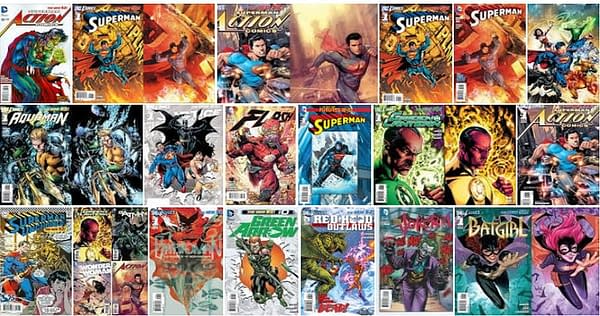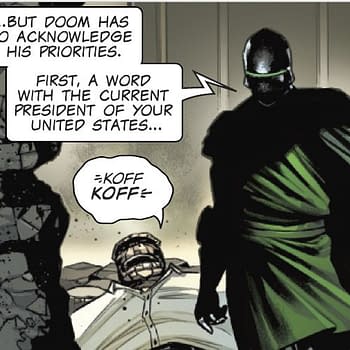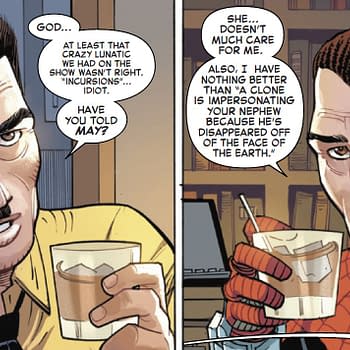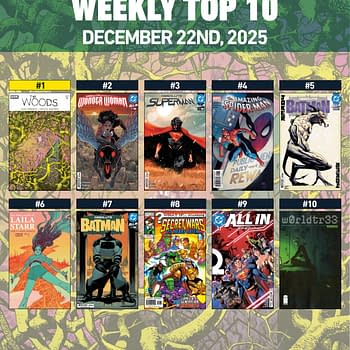Posted in: Comics, DC Comics | Tagged: Comics, dc comics, new 52
Editorial And Creative Clashes In DC Comics' New 52, Ten Years On
Friend of Bleeding Cool. Graeme McMillan has put together a 10,000 word "oral history" look at the launch of DC's New 52, ten years ago for Polygon. A relaunch that Bleeding Cool first scooped the before launch, some of these insights we managed to report on at the time, others we did not… here are a few examples, the full article can be found right here.

It has been commented many times that then-co-publisher Dan DiDio is a cross between Jim Shooter and Bill Jemas, and was always trying to do a Marvel Comics at DC Comics – with the New Age Of DC Heroes launch being his most blatant attempt. But it was there at the beginning.
Dan DiDio: Marvel had such success with [Miles Morales and the Ultimate line], and I kept on pointing to that. I thought to myself, We needed that.
On what Demon Knights was meant to be…
Paul Cornell: Editorial was meant to have put together an enormous backstory on a wall chart, but I never got to see it. I was initially asked for Demon Knights to be a sort of medieval Justice League, so I initially pitched a bunch of characters who were reasonable representations of later heroes who could be represented at the time: A stranded Green Lantern, a Captain Marvel, a Hawkman and Hawkwoman, for example, and cheeky ideas like Matthew Wain, a cart-maker who became someone very like Batman. But just about every one of them was taken away by editors keen to protect their own franchises, until I was left with mostly mystical characters, so I went with that. When the Demon clearly became the lead, I called it Demon Knights, which was meant to be something to do with "Daemonites" [an alien race that originated in the 1990s series WildCATS, mentioned often in early New 52 titles], but with everything changing all the time, I don't know how much we ever landed that connection.
On Scott Snyder dealing with editorial interference
Scott Snyder: We'd finished [the first Batman storyline] "Court of Owls." It was at the printer, and word came down from above that they weren't sure that they wanted Batman not to be able to solve the mystery of the Owls; whether Lincoln March was his brother. They wanted us to change it, to make it so that he'd definitively solved it. For me, that would have changed the entire story, because the point of the story was just the opposite. I remember standing in Target, pushing a cart of paper towels, screaming into the phone, "You go down the hallway and you tear up my contract!"
On how Superman and Action Comics didn't work together.
Dan DiDio: The George and the Grant stories never really lined up and, in the end, for the fans that really follow the tight continuity, they had a hard time grasping how these two characters were the same one, or how that timeline worked.There was probably going to be a greater role for the Pandora character early on. She was going to be a little bit of a mechanical character behind the scenes who was working some of the differences out on how the world moved forward from what happened prior to Flashpoint.
What Scott Snyder would have liked Pandora and Dr Manhattan to be;
Scott Snyder: My big regret, architecturally, is that in all the exuberance we didn't get a chance to build something equally exciting when it came to an overarching story, something to play out in a year or two, something that spoke to the spirit of the whole initiative. Something risky and bold but that also eventually looked back at legacy, like, "OK, the story is, Darkseid removed five years from everyone's lives, and the only character that knows this is Pandora, and she's going to go through this and this and this, but it'll play out over a couple years, and so hint at that and that and that, and in the end, what the heroes will realize is, new is good, change is good, but you have to respect the past too and that's what the final fight with Darkseid will be about."
On what happened to Martian Manhunter in Stormwatch…
Paul Cornell:We could and couldn't have the Martian Manhunter in Stormwatch because he was and wasn't going to be in Justice League. What the Stormwatch mythology meant to the wider universe kept changing.
On the powers that be demanding Eclipso in Amethyst.
Christy Marx: I worked with editor Rachel Gluckstern, and I thoroughly enjoyed working with her. She's a sharp, perceptive, and supportive editor. There were times when she had to come to me with last-minute, pain-in-the-ass requirements from the higher-ups, like having to suddenly insert an issue in Amethyst where she comes back to the DC universe world, even though this is right in the middle of a storyline I had going on in the Gemworld. Or at the end, where I suddenly had to introduce Eclipso because they wanted more crossover with the larger DC universe.
On cancellations leading to more cancellations;
Dan DiDio: One of our staples at the beginning was we wouldn't let any book go under 20,000 in sales. OK. So that's why you saw cancellations at eight months, because the books were making money, they were profitable, they just didn't hit this artificial number that was created. What we didn't realize at that time is, we created the churn, as I called it. There are going to be eight books or so that are just going to [come in below our target number], so what you should do is find the best eight and stick with them. But [if you cancel and replace them], you find out that you were getting even more diminishing returns. Then all of a sudden, the eight [books below our target number] become 10, and then you're filling more holes than you have ways to fill them.
And what happened to Paul Levitz and Daniel Wilson on Earth 2;
Daniel Wilson: I had a lot of characters to deal with, so I put together a big spreadsheet. I had basically the whole thing planned out — the major beats of what I wanted to do and how I wanted to separate everything. So I went to New York City, I met [former DC publisher] Paul Levitz, and I sort of just had this immediate reality check where Paul was like, "No, like, that's not how you do comics, man." I'm like, "Well, how else are we going to do it? Because there's so much I need to just lay this out," and he's like, "No, no, we'll just figure it out issue to issue." [I said] "I'm really not comfortable doing that, Paul, and I'm the showrunner. So I kind of want to do it this way. Also, I've been working on this for months to figure it out." Paul was like, "'That's cool. I wish you luck. I'm out." That first issue was really hard. It got all the way to inks before I had to do major modifications. We were having a great time, but sometimes things got tense, and you start going, "Come on, man!" There's so many steps to getting a comic made, and there's so many spots where you can get out of sync with other people. [My editors were] like, "No, we liked it, the next person liked it, maybe the next person up after that didn't like it, but they can't read the full output every day, right, so there's a delay? Yeah, it sucks that we didn't find out until now." But that doesn't change anything. You just have to figure it out. It was one of those classic things where I kind of found out I wasn't doing it because I saw a different person's name on it [in the solicitations]. That's comics for you. Yeah, I wasn't thrilled about that.
Graeme also cited "One writer, who asked not to be named in this article, described their experience with editorial on one title as "a complete nightmare," adding that their direct editor was "the worst editor I've ever worked with; he literally rearranged the page order after the art had been finished, not to tell the same story in a different way, but to complete a completely different story, which I then had to write dialogue for and follow up with something that made even slight sense in an already-prepared second issue! He was one of those guys who felt he was a genius and that his every idea had enormous merit, and he was completely wrong about that." Place your bets… Andy Diggle, John Rozum, Rob Liefeld, Joshua Fialkov, Tony Lee, so many similar sounding experiences…
Here's how we reported a few of the stories mentioned in the article. Andy Diggle left Action Comics before the first issue was published, and Joshua Fialkov did the same off his two Green Lantern books. after being told to kill off John Stewart, Green Lantern. Then there were big changes on a number of titles, including Gail Simone leaving Batgirl, then that she had been fired by one editor, was rehired two weeks later after social media fuss, then later that she left again over creative differences with another editor,
There were plenty of other creative/editorial clashes during the New 52 that didn't make it to the Polygon article. It could only be 10,000 words long, after all. Bleeding Cool scooped the news that John Rozum quit Static Shock, JT Krul was dropped from Green Arrow the week the first issue was released, Ken Lashley leaving Blackhawks, Alessandro Vitti announced but not drawing a page of Blackhawks, Roger Robinson off Mister Terrific, Rob Liefeld quitting three New 52 books at once,Robert Venditti, the announced writer of the all-new Constantine book, replaced by Ray Fawkes before his first issue is out. Jim Zubkavich, hired to write Birds of Prey, is removed from the book and replaced by Christy Marx before his first issue is out. Keith Giffen leaves Paul Levitz and Legion of Superheroes after just two issues. Mike Johnson left Supergirl earlier than expected, with his name still on the cover of a book he was supposed to write and didn't. DC replaces Mico Suayan as artist on Red Hood and the Outlaws after the cover to #19 leaks though the book's credits aren't changed. James Robinson quit DC Comics and Earth 2 after Daniel Wilson was picked to write the second Earth 2 book. Justice League 3000 was to reunite Keith Giffen and J.M. DeMatteis with Kevin Maguire, but then fired Maguire, replacing him with Howard Porter. And JH Williams III and W Haden Blackman quit Batwoman after plans to allow Batwoman to marry her girlfriend were rescinded.
Creators who contacted Bleeding Coo back thenl told us that "editorial has a right to dictate how their lines should progress, but not at the last minute and while changing other parts. Stop trying to please all of the people all of the time and just try to tell a solid story." And at a creative conference in Burbank, Dan DiDio apologised to creators gathered around. We reported that with then-President Diane Nelson to his side, DiDio admitted that there had been problems in the editorial chain, apologised for the repeated back-and-forths on people's scripts and art, and committed to reducing such editorial inputs once an editorial direction has been agreed upon and approved. And Diane Nelson said she'd ensure this happened."
No, of course it didn't…











